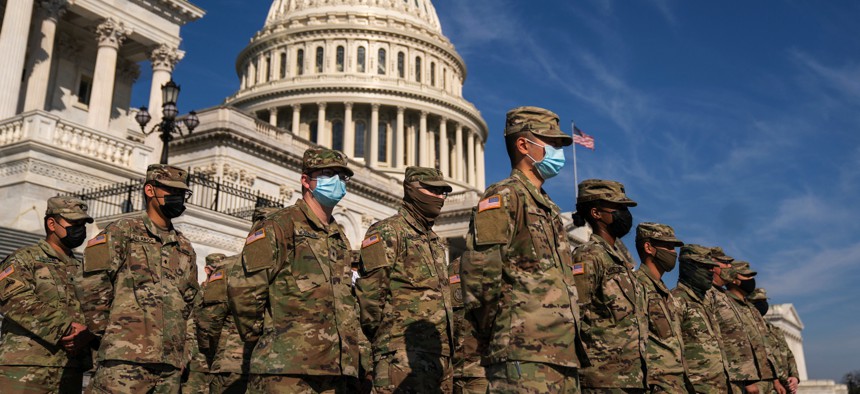National Guard Scrambles for Funds After Congress Refuses to Cover Jan. 6-Related Costs
More than a half billion dollars in the hole, the Guard’s chief has ordered the heads of the Army and Air Guards to claw back money from state units.
The heads of the Army and Air National Guards were ordered on Thursday to pull back all unspent funds sent to state units, a last-ditch effort to cover basic expenses after the response to the Jan. 6 Capitol riot left the force $520.9 million in the hole.
Congress so far has not reimbursed the National Guard for the cost of sending more than 25,000 troops to Washington, D.C., to fortify the Capitol and provide security for the inauguration of President Joe Biden in the wake of the riot. Thousands of Guardsmen remained in the city through March, manning eight-foot fencing and checkpoints surrounding the Capitol complex.
The National Guard Bureau “has not received assurance of reimbursement and therefore must take fiscally responsible steps to retain solvency,” Chief of the National Guard Bureau Gen. Daniel Hokanson wrote in a July 15 memo to the directors of the Army and Air National Guards that was obtained by Defense One. “I am directing you to pull back unexecuted federal funds from the states, territories and District of Columbia beginning 1 August 2021.”
Hokanson has urged Congress to reimburse the force, warning that the Guard did not have the money to pay for the deployment out of pocket and that if the force wasn’t paid back, they would have to make steep cuts to training and drills, and might not be ready to deploy to respond to an emergency.
The House has passed a bill to reimburse the Guard, but to date, the Senate has not.
The pullback will hit state National Guard units just as record heat and drought is spurring another dangerous wildfire season on the West Coast and as the East Coast and Gulf States enter another potentially record-breaking hurricane season.
To preserve the most funds possible, “we must take prudent actions, which may include cancellation of drill and annual training, reductions to flying operations, cancellation of non-essential travel and training and cancelation or deferment of facility sustainment projects,” Hokanson directed in the memo.
Cutting training, particularly flying hours, can have deadly consequences. A U.S. Army Combat Readiness Center flight mishaps review found that of the 53 Class A mishaps the Army has seen over the last five years, 22 occurred in July, August, or September. The reviewers found August becomes a more dangerous month for flights because aviators have not had as many flight opportunities due to July vacations or unit rotations, and then pilots have to cram in flights in August to meet annual flight hour requirements.
National Guard service members were deployed the equivalent of 21 million personnel days in 2020, reaching a peak in June 2020 with more than 120,000 of its 440,000 members deployed in response to domestic unrest, COVID, wildfires, and overseas deployments, which was the highest number of Guardsmen deployed at any time since World War II, the Guard said in a roundtable with reporters earlier this year.








